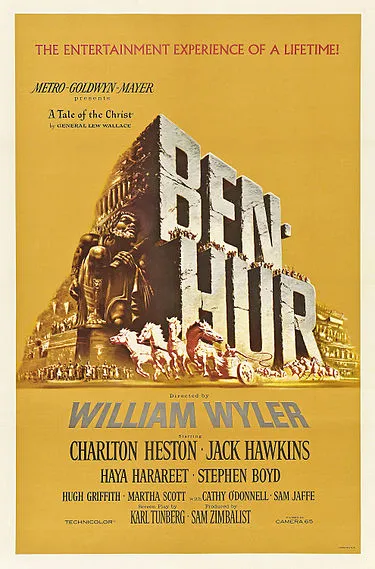Historical accuracy of Ben-Hur

Historical accuracy of Ben-Hur

Characters
Judah Ben-Hur (Charlton Heston)
The protagonist is entirely fictional, created for Lew Wallace's novel to explore themes of faith, betrayal, and redemption against a historical backdrop.
Messala (Stephen Boyd)
A fictional character representing Roman ambition and the conflict between Roman authority and Jewish identity; serves as Judah's primary antagonist.
Quintus Arrius (Jack Hawkins)
While Arrius is a plausible Roman name and adoption existed, this specific character and his adoption of a galley slave are fictional plot devices.
Jesus Christ (Claude Heater)
Depicted respectfully (often without showing his face directly) during key moments (giving water, Sermon on the Mount, Crucifixion), generally aligning with New Testament accounts.
Pontius Pilate (Frank Thring)
The actual Roman governor who presided over Judea during Jesus' ministry and crucifixion. His presence and role in the film are historically grounded.
Emperor Tiberius (George Relph)
The reigning Roman Emperor during the period; appears briefly when Judah is presented in Rome by Arrius.
More characters
Balthasar (Finlay Currie)
Represents one of the biblical Magi who visited the infant Jesus. His role as a wise figure interacting with Judah throughout the film is a fictional extension.
Sheik Ilderim (Hugh Griffith)
A fictional character who provides Judah with the means (horses) to compete in the chariot race.
Esther (Haya Harareet)
A fictional character serving as Judah's primary love interest.
Miriam (Martha Scott)
Fictional mother of the protagonist.
Tirzah (Cathy O'Donnell)
Fictional sister of the protagonist.
Simonides (Sam Jaffe)
A fictional character representing loyalty and Jewish resilience.
Story
Roman rule over Judea
The film accurately portrays the historical context of Judea as a province under Roman occupation during the 1st century AD.
Judah sentenced to galleys for accident
This central plot point, driving Judah's enslavement and desire for revenge, is entirely fictional.
Use of chained slaves rowing Roman warships
This is a major historical inaccuracy popularized by the film. Roman war galleys were primarily rowed by trained, free sailors and marines, not chained slaves.
Judah rescued/adopted by Roman Consul Arrius
A fictional event enabling Judah's return to prominence and path to the chariot race. Roman adoption existed, but not typically under these dramatic circumstances.
Chariot racing as popular Roman spectacle
Chariot racing was immensely popular in the Roman world, often held in large circuses like the one depicted (set in Antioch, though sometimes mistaken for Rome's Circus Maximus).
Specifics of the chariot race depiction
While capturing the spectacle, the film includes inaccuracies like bladed wheels (a myth), the number of laps, and perhaps exaggerated violence compared to typical races (though crashes were common).
Jesus' ministry occurring in background
The film accurately places Judah's fictional story during the historical period of Jesus' ministry in Judea.
Judah witnessing Sermon on the Mount
A fictional intersection between the protagonist and a historical/biblical event.
Judah witnessing the Crucifixion
Another fictional intersection, used for dramatic and thematic effect as Judah's quest for vengeance gives way to forgiveness.
Depiction of the Crucifixion event
The portrayal aligns with New Testament descriptions of the event, including the atmosphere and key moments, though artistic choices (like nail placement) exist.
Existence of leprosy & social ostracization
Leprosy (Hansen's disease) existed, and sufferers faced significant social stigma and isolation in antiquity, often being forced into colonies as depicted.
Miraculous healing of Miriam and Tirzah
The healing of Judah's mother and sister from leprosy through divine intervention (rain during the Crucifixion) is a fictional event serving the film's religious themes.
Jewish desire for freedom from Roman rule
The underlying tension and desire among some Jews for liberation from Roman occupation, which Judah initially shares, is historically accurate.
Setting
Roman Judea (Jerusalem, Nazareth)
Sets and locations effectively evoke the atmosphere of 1st-century Judea under Roman control, blending historical styles with epic filmmaking scale.
Roman Empire (Rome, Sea Battles)
Provides glimpses of Roman power, architecture (in Rome), and naval presence, creating a believable backdrop for the era, albeit through a Hollywood lens.
Architecture (Roman & Judean styles)
The film's grand sets showcase Roman architectural elements (columns, arches) and attempt to depict Judean domestic architecture, praised for its scale and detail.
Costumes (Roman & Jewish)
Costumes effectively differentiate between Roman military/official attire (armor, togas) and Jewish civilian clothing, contributing significantly to the period feel.
Roman Military Equipment & Appearance
Legionary armor, standards, and the overall look of Roman soldiers are depicted consistent with popular understanding and historical reconstructions of the time.
Galley Ship Interiors
Visually striking but historically inaccurate due to the depiction of chained slaves as rowers.
Chariot Circus (Antioch)
The massive set successfully conveys the scale and grandeur of a major Roman circus designed for chariot racing.
Valley of the Lepers
Effectively portrays the isolation and grim conditions imposed on those suffering from leprosy, reflecting historical societal attitudes.
Use of Star of David
The Star of David is shown as a symbol of Judaism (e.g., on a pendant). This symbol did not adopt this specific meaning until the Middle Ages, making its use anachronistic.
